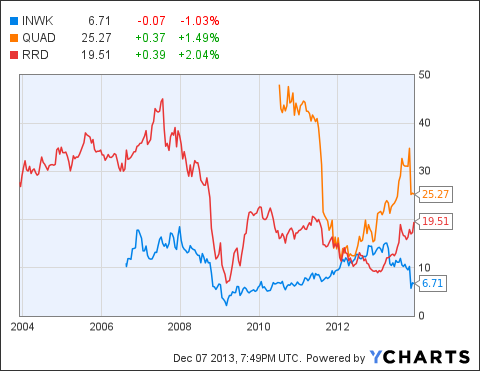General Moly This $1 Steel Rebound Play Is A Top Pick For A January Effect Rally General Moly
Post on: 21 Июнь, 2015 No Comment

General Moly, Inc. (NYSEMKT:GMO ) shares have been battered in 2013 for a number of reasons including weak metals prices and production delays, however, the stock appears to have bottomed out now and it could soon act like a coiled spring in January, as it rebounds from oversold levels due to the end of tax-loss selling pressure and even short covering. This stock started out 2013 by trading at a 52-week high of $4.25 on January 7, but more recently it has been hammered by plenty of tax-loss selling and short selling which has pushed the shares near 52-week lows of just over $1.
This is a great time of year to buy cheap stocks from frustrated investors who are selling shares in order to harvest tax-losses. With this stock trading for about a quarter of its 52-week high, it’s easy to see that many investors have losses and that makes this stock a prime candidate for tax-loss selling. As the chart below shows, General Moly shares were very recently trading for about $1.60, but as tax-loss selling season started in November and continued into December, this stock has not been able to have a break and it has been pushed down to about $1.17. The chart also shows that the 50-day moving average is about $1.42 per share and the 200-day moving average is around $1.80 per share.
Significant Near-Term Upside Potential As Tax-Loss Selling Ends And A Potential Short-Covering Rally Begins:
Once tax-loss selling pressure ends, this stock could begin a strong snap-back rally which could take the shares somewhere between those key levels (the 50- and 200-day moving averages) of $1.42 to $1.80. As the tax-loss selling ends, it should show increased strength and this often leads to a short-covering rally. There is a significant short interest in this stock and many of them have made strong gains, but probably would prefer to defer taxes on those gains by waiting to cover in January 2014. By doing this, it will postpone tax liabilities for another year; because of this, there is a strong chance that the combination of the end of tax-loss selling and short covering in early January will make the stock jump.
According to Shortsqueeze.com, there are over 3.7 million shares short. Average daily volume in this stock is about 354,000 shares, so the short interest is equivalent to around 11 days worth of trading volume and about 11% of the float. Shorts have greatly benefited from tax-loss selling pressure in recent weeks, but the tide is about to turn with the end of tax-loss selling pressure and investors could take a fresh look at the positive long-term fundamentals and upside catalysts for General Moly:
Company History, Valuable Partnership Deals and Reasons Why Molybdenum Is A Key Industrial Metal:
General Moly is developing two major molybdenum projects and its goal is to grow into the largest pure-play molybdenum producer in the world and a molybdenum supplier of choice to customers around the world. Both of its projects are based in Nevada which means that geopolitical risks are essentially eliminated. Its Mt. Hope Project is fully permitted which greatly reduces downside risks for investors. Furthermore, it is one of the world’s largest molybdenum development projects and is a joint venture between General Moly, which has 80% ownership and the rest is owned by POSCO (NYSE:PKX ), which is a major South Korean company and one of the world’s largest steel producers. General Moly also has 100% ownership of its Liberty Project which has molybdenum and copper.
The joint ownership of the Mt. Hope Project with POSCO is significant as it validates the potential of this mine and also because POSCO consumes a large amount of molybdenum in order to make steel. General Moly has also attracted the interest of another huge steel company. In 2007, it raised $70 million through a private placement with ArcelorMittal (NYSE:MT ), another global metals giant which also consumes significant amounts of molybdenum. It appears that POSCO and ArcelorMittal will both have vested interests in the success of General Moly and potentially be significant customers.
The use and price history of molybdenum needs to be considered next. Molybdenum is the 42nd element on the periodic table and it has the sixth highest melting point of any elements, which makes it ideal for use in construction, metals, and many other industrial applications including military and space exploration (because of its strength and heat resistance.) According to Commerce Resources Corp. this following break-down shows how molybdenum is used:
- 37% is used to create construction grade steel.
- 22% is used in the manufacturing of stainless steel.
- 15% is used in chemicals such as lubricant grade MoS2.
- 9% is used in the creation of tool and high-speed steels.
- 7% goes towards cast iron.
- 6% in molybdenum metal.
- 4% towards super alloys.

Molybdenum is primarily used as an alloy agent when manufacturing steel. It increases the strength, resistance to corrosion and extreme temperature capabilities of steel. Molybdenum is also vital in the chemical and oil industry as it acts as an agent to remove sulfur from liquid fuels. Before the 2008 financial crisis, molybdenum prices were averaging over $30 per pound, but were crushed down to about $9 per pound and have remained depressed. However, things could be at a major inflection point and an improving global economy could be setting the stage for a large rebound in molybdenum prices. With General Moly trading for just over $1 per share, it is almost like buying an option that could become a multi-bagger when prices rebound. For this to happen, the economy needs to continue growing and demand for steel in particular needs to increase.
A Cheap Way To Play the Turnaround In the Steel Industry:
While the steel industry has yet to fully recover, by taking a look at the stock charts of POSCO, ArcelorMittal, and U.S. Steel (NYSE:X ) below, it is clear that the market is starting to expect much better days ahead for the industry. POSCO, ArcelorMittal and U.S. Steel shares have all started a major uptrend recently and this sign of strength should eventually begin to benefit companies like General Moly because as steel demand grows, so will demand for molybdenum. Investors looking for bargains in the stock market and cheaper ways to play the emerging recovery in the steel industry could begin to take an interest in beaten down stocks like General Moly. Take a look at the charts of these leading steel companies below which seem to confirm that this industry (and therefore molybdenum demand) is coming back:
Risks and Rewards:
General Moly has a strong balance sheet with about $27 million in cash and almost no debt (just around $874,000). The cash on the balance sheet is equivalent to nearly 30 cents per share and the book value is about $1.48 per share. This solid balance sheet reduces risks for investors. The company will probably increase its debt levels in the future in order to complete mine engineering and maximize future production and revenues, which could be a potential downside risk for investors (if terms are not favorable), but if they are, the stock could surge. The other potentially significant downside risks include production delays and/or if molybdenum prices were to decline, but that does not seem likely now and especially not at these low levels. In order to get a sense of the value of the stock and the upside potential it offers if molybdenum prices rise, it is worth considering the following statement made by General Moly (especially the underlined part, considering the market capitalization is just over $100 million today), in a recent shareholder update on the project which states :
On a look forward basis, economics for General Moly’s 80% ownership in the Mt. Hope Project, at a $15.00 per pound flat long-term molybdenum price, anticipates an after-tax Net Present Value (NPV), discounted at 8%, to be $707 million and an internal rate of return (IRR) of 17.6%. General Moly’s 80% ownership in the Mt. Hope Project, which includes the impact of off-takes, other contractual agreements and specific working capital assumptions, equates to $7.72 per current outstanding share. For every $1 change in the molybdenum price between $10 and $20 per pound, the after-tax NPV of the Mt. Hope Project changes by approximately $190 million. The Mt. Hope Project is NPV breakeven at an approximate $11.15 per pound molybdenum price and undiscounted cash flow breakeven (going forward excluding sunk capital as of October 2013) at approximately $9.75 per pound molybdenum price.
The fact that General Moly has a market capitalization of just over $100 million and that just a $1 per pound increase in the price of molybdenum is equivalent to about $190 million in NPV or net present value, shows why this stock could be like an option on the rebound in steel and a potential long-term multi-bagger. In spite of the currently soft market price for molybdenum and the project delays, some analysts are bullish on this stock. On December 6, 2013, Zacks Equity Research issued a buy rating on the stock and encouraged with a small rally in the stock, Zacks’ stated. . make sure to keep a close watch on this firm in the near future.
While this stock still appears speculative, the long-term upside potential could be in the multi-bagger range, especially if management executes, and if molybdenum prices rise. With the global economy showing renewed signs of strength, and the steel industry stocks indicating a turnaround is coming, it appears to be an ideal time to buy this stock. Furthermore, with steel industry giants already showing significant interest in General Moly, it would not be surprising for the company to be targeted as a takeover. In the short term, these shares appear poised for a January Effect Rally that could be sparked by the end of tax-loss selling and short covering. Based on the short interest and the 50- and 200-day moving averages, I believe this stock could trade back at around $1.50 to $1.80 in January which is where it was in early November before tax-loss selling began. This could give investors gains of about 50% in the near term. Longer-term, the share price will depend on how strong molybdenum prices rebound, but the potential upside appears very significant.
Here are some key points for General Moly, Inc.
Current share price: $1.18
The 52-week range is $1.04 to $4.25
Data is sourced from Yahoo Finance. No guarantees or representations are made. Hawkinvest is not a registered investment advisor and does not provide specific investment advice. The information is for informational purposes only. You should always consult a financial advisor.
Disclosure: I am long GMO. I wrote this article myself, and it expresses my own opinions. I am not receiving compensation for it (other than from Seeking Alpha). I have no business relationship with any company whose stock is mentioned in this article.














